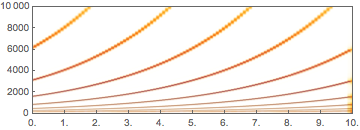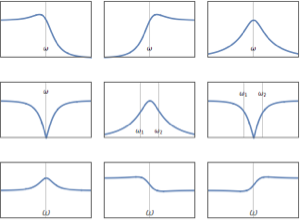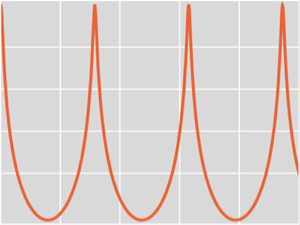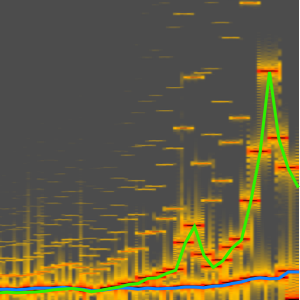Shepard's Tone: An Auditory Illusion
Create an auditory illusion.
In[1]:=
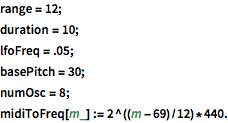
range = 12;
duration = 10;
lfoFreq = .05;
basePitch = 30;
numOsc = 8;
midiToFreq[m_] := 2^((m - 69)/12)*440.Generate ramps to control frequencies and amplitudes of the oscillators.
In[2]:=

phasors =
Table[AudioGenerator[{"Sawtooth", lfoFreq, 2. Pi/numOsc (i - 1.)},
duration, SampleRate -> 500]/2. + .5, {i, numOsc}];
AudioPlot[phasors, PlotLayout -> "Overlaid", PlotRange -> All]Out[2]=

Create frequencies that will control the oscillators. The frequencies are exactly one octave apart from each other and increase exponentially, so that pitch increases linearly.
In[3]:=
freqs = Table[
midiToFreq[(phasors[[i]])*12*numOsc + basePitch], {i, numOsc}];
AudioPlot[freqs, PlotLayout -> "Overlaid", PlotRange -> All]Out[3]=

Create amplitudes that will control the oscillators. Amplitudes go to 0 when the frequencies drop to the minimum value.
In[4]:=
amps = Cos[#*Pi - Pi/2.] & /@ phasors;
AudioPlot[amps, PlotLayout -> "Overlaid", PlotRange -> All]Out[4]=

Show the relation between frequency and amplitude of one oscillator.
In[5]:=
AudioPlot[AudioNormalize /@ {freqs[[2]], amps[[2]]}, PlotRange -> All]Out[5]=

Combine a bank of oscillators using the created frequencies and amplitudes.
In[6]:=
res = Mean[
Table[amps[[i]] AudioGenerator[{"Sin", freqs[[i]]}], {i, numOsc}]]In[7]:=
Spectrogram[res, 8192, 4096, HannWindow,
PlotRange -> {All, {0, 10000}}, ImageSize -> Medium]Out[7]=
